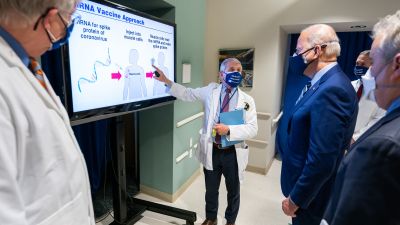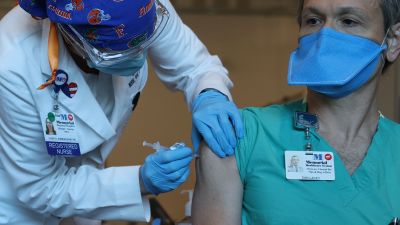
Image by Karolina Grabowska for Pexels
This article is adapted from Unsanitized: The COVID-19 Daily Report put out by The American Prospect. You can find the original publication here.
First Response
We are now four days away from a self-imposed Congressional deadline to pass an omnibus spending package that will fund the government through next September, the last train leaving the station for COVID-19 relief this year. Yesterday the bipartisan “908 Group” or “Gang of Eight” or “New York Dolls” or whatever nickname they’ve given themselves finally released, on December 14, actual text of their agreement on the relief package. This will get discussed in the media as a $908 billion package but it’s surely not; it’s $748 billion in the part that matters, the part that actually has a chance to pass.
One contentious issue was a corporate liability shield for negligence in exposing customers or employees to the virus. We actually have text on that and it’s much worse, retaining the McConnell/Cornyn provisions that would block lawsuits over a host of employment laws like the Federal Labor Standards Act, Title VII of the Civil Rights Act, Title I of the Americans with Disabilities Act, and the WARN Act, which gives workers notice before firing. It also would allow the Justice Department to prosecute lawyers who seek information from employers about COVID exposure.
The thing is, only Sen. Joe Manchin (D-WV), in the end, agreed to that language. That’s not enough to pass a bill. So they packaged it with something Democrats had to sacrifice: $160 billion in state and local fiscal aid, derided as a “blue state bailout” by Mitch McConnell but actually a desperately important measure to prevent long-lasting austerity that will subvert efforts at the federal level toward economic recovery.
Those two pieces are put into a separate bill from everything else. The state/local aid and liability shield bill is designed not to pass. So as bad as the liability protection is, it’s also irrelevant. It won’t become law in this Congress.
Let’s then move to the part that does have the potential to pass. I only say “potential” because there’s no final answer on whether Democrats will accept something without state and local aid, though they’re certainly talking like they will. The fact that there’s a second bill can allow them to say they were for it but merely outvoted. It seems like Republicans will support the $748 billion package as well, at least in enough numbers to pass it, but again there’s no clarity here. I should say that splitting the bills apart was McConnell’s idea, so it’s likely that he’d bring it to the floor with enough votes on his side to support it if Democrats agree.
The bill includes the $300/week enhancement for all forms of unemployment benefits for 16 weeks. It extends the two expiring programs—one for gig workers and freelancers, the other for extended benefits—also by 16 weeks. No retroactive benefits are granted. The bill renews the Paycheck Protection Program with $300 billion for small business, including more money for the Economic Injury Disaster Loan (EIDL) program and a second draw for those who have already received a forgivable loan. (This part, incidentally, does allow 501(c)(6) organizations to get PPP loans: that includes chambers of commerce, boards of trade and other “business leagues.”)
There’s $82 billion for schools; $45 billion for transportation (of which I believe the majority goes to airlines); $35 billion for health care providers; $25 billion for rental assistance and an extension of the eviction moratorium to January 31 (at which point the new president can extend the current moratorium through executive action); $16 billion for vaccination costs and testing and tracing (a shockingly low number); $13 billion for farmers and fisheries; $13 billion for enhanced nutrition assistance and food bank funding; $12 billion in low-income community grants; $10 billion for child care providers; $10 billion for broadband deployment (a nice long-term investment but puzzling in an emergency bill); the forgiveness of a $10 billion loan to the U.S. Postal Service; $5 billion in emergency substance abuse prevention; an extension of student loan forbearance to April; and the extension of an obscure CARES Act provision that allows defense contractors, alone among every profession, to be paid not to work.
The bill is partially “paid for” with $430 billion from the Treasury/Federal Reserve “money cannon” and $130 billion left over from the previous PPP. This means that there’s only $188 billion in “new money,” but that’s really an accounting gimmick. The old money wasn’t getting used, and the majority of it was earmarked to corporate bonds. You could stretch and say that some of it could have gone to state and local governments in Fed loans, but the Fed has the power to make those loans under its own authority right now, and should be pressured to do so.
This bill is more than McConnell has previously offered, by my count. (The HEALS Act, which had nominally more spending, included the poison pill liability shield and as such wasn’t a serious effort. It also didn’t even have enough support among Republicans for McConnell to pass it; his eventual “skinny” bill was $650 billion.) It fills a number of holes with inadequate but still extant funds. If you want to be mad about it, be mad that we’re in the middle of a historic state and local budget crisis, with more burdens being placed on these governments due to vaccination costs—only a portion of which would be covered by this bill—and the feds still haven’t appropriated one dollar to cover those shortfalls. That will have long-lasting effects, stunting economic growth in 2021 with local austerity.
Whether Democrats will take what’s left depends on developments. One-time stimulus checks of $1,200—one-quarter of the full 16-week enhanced unemployment value—are not part of the bill, and Bernie Sanders among others are pushing for their inclusion. If the bipartisan bill cost was an upper bound you could probably back into $160 billion in checks by substituting them for the state and local funding. They’d be pretty means-tested at that number, however. And conservatives might peel away if any additional costs are added, at which point you’re trading checks for something else.
Sanders is calling for a rejection of the package, saying that going from the $3.4 trillion Heroes Act to $188 billion in new money is “a collapse” for Democratic negotiators. Let’s remember that the die was cast on this in March. Republicans got the corporate bailout they wanted and turned away from any other relief. Democrats were forced to negotiate with themselves because they failed to provide relief in the initial package for the duration of the national emergency, and it predictably ran out. The failure was present at the outset. The “negotiations” since have been play-acting. Only the threat of Republicans losing the Senate in Georgia has made them willing to go even this far.
So Nancy Pelosi and Chuck Schumer blew it, but they blew it a long time ago, during the original CARES Act that everyone supported, including Sanders. He can take a little blame for that himself, actually.
Days Without a Bailout Oversight Chair
263.
Today I Learned
- The Moderna vaccine is going to be approved this week, we’re on track to have a significant number of vaccinations by spring. (New York Times)
- What might end up in short supply is dry ice—thanks to concentration. (Acute)
- Yes, rich countries are scooping up the vaccines, and this will become a humanitarian crisis. (New York Times)
- Amazon under fire from California in a workplace investigation involving virus exposure. (Reuters)
- Employment is worse than the headline rate, probably close to 9.6 percent. (Calculated Risk)
- A White House official spent months in the hospital from COVID. (Bloomberg)
- Here are the highest death rates from COVID in the world. The U.S. is actually just on the edge of the top ten. (Axios)
- We’re all sitting at home and buying cheap crap from China. (New York Times)




